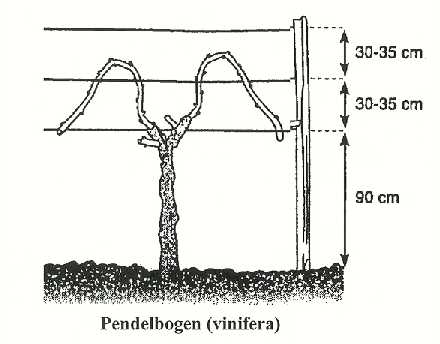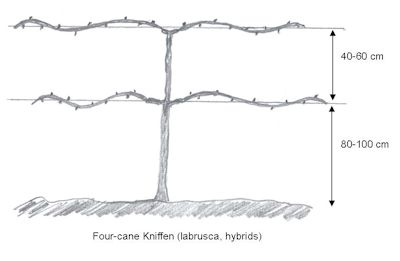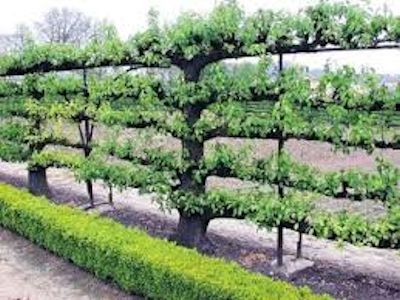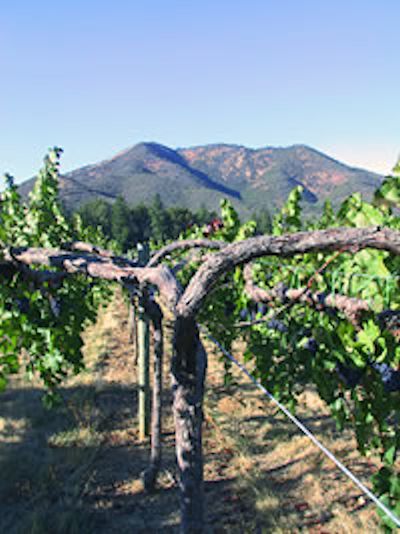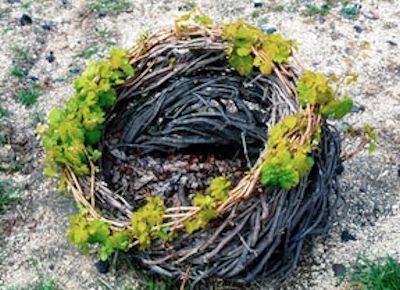Robert Bell's
Wines of Canada
Since 1992
Vine Training
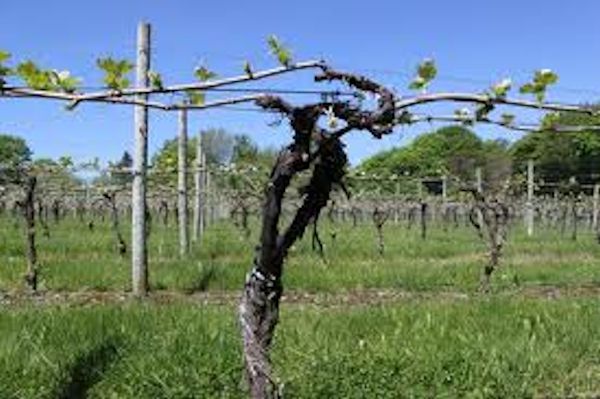
Many winemakers and growers will tell you that the quality of the wine begins in the vineyard. It is the way in which the variety is grown that has the most profound effect on the quality of the wine . Today one of the most import person, yet seldom mentioned is the vineyard manager or grape grower.
There is a direct relation between the vine, the grape and the sun.
The way to maximize the performance of a grapevine is to balance the amount of fruit development with the amount of energy-producing parts of the vine (leaves). Having too much fruit without having enough energy-producing leaves will result in an imbalance. This imbalance creates an environment in which the grapes cannot fully ripen and the vine is stressed by trying to provide all the grapes with sufficient energy, even though it cannot. The vines will allocate some of the energy to the fruit instead of retaining sufficient energy for overwintering and for use during the following spring. (9)
In Vine Training it is absolutely crucial to ensure that no cane ever touches the ground. Should a cane find its way to the ground, its natural inclination is to send out suckers that will put down roots. The method employed is far more importance than you may think - it is not simply a job of keeping the vines from dangling on the ground. Many dozens of different training techniques have been developed, some of which have been in use for centuries, such as gobelet, and some for just decades, such as Scott Henry and Smart Dyson. The different methods assist in controlling vigorous vines that produce too much foliage and not enough fruit(2)
There are a number of very effective systems used to train the vines. It is up to the individual to chose what is best for their vineyard.. In Canada been such a large country extending from the Atlantic to the Pacific numerous methods are used in the vineyards
In the Niagara Peninsula several systems of training are followed, such as Pendelbogen, Umbrella Kniffen, four- and six-cane Kniffen. Kniffen and Pendelbogen are the most common. The main advantage of following a particular system is that the work, particularly pruning and tying, is simplified and standardized
Pendelbogen
Pendelbogen—Cane-training system Also known as the “European Loop,” or “Arc-Cane Training,” this vine-training system, which is a variant of the Guyot Double (see left), is most popular in Switzerland and the flatter Rhine Valley areas of Germany and Alsace, although it can also be found in Mâcon, British Columbia, and Oregon. By bending the canes in an arch, Pendelbogen has more fruit-bearing shoots than the Guyot Double system, thereby providing higher yields. The arching does promote better sap distribution, which helps the production of more fruit, but it can also reduce ripeness levels, making the prime motive for adopting Pendelbogen one of economy, not of quality .(1)
Alvento Winery in Vineland, Ontario uses the Pendelbogen method for vine training. Anarchist Mountain Vineyards in the BC Okanagan is another winery using Pendebogen.
Type of training system used in younger vineyards where six canes are trained to three wires. With this system, growth is spread over a large area. The spreading lessens disease and hastens ripening. Most growers prefer the six-cane Kniffin system because selection of fruiting canes and tying are generally easier There is also the four cane system.
Taille Chablis Vine training
Taille Chablis (spur trained)
As the name implies this system was developed in the Chablis district, although they now in fact use the Guyot Double instead. Champagne is the most important area for using the Taille Chablis system, where it now accounts for over 90% of Chardonnay plantings. It is a slanting bush vine system, without the support of a central post. Three, four, or five permanent branches may be cultivated, with each being grown at yearly intervals. The distance between each vine in the same row determines the eventual life of the oldest branch, as once it encroaches on the next vine it is removed and a new one will be cultivated from a bud on the main trunk.
GobeletLiterally translating as 'goblet', this ancient method of vine training involves no wires or other system of support, and results in a goblet shaped growth. The trunk of the vine is kept short at about 0.5m, and it is crowned by a knarled lump of old wood, which is the result of years of spur pruning the few branches at the head of the trunk. Vines trained in this manner, referred to as 'head training', essentially resemble a small bush or shrub, and they may be described by some as 'bush vines'. They are best suited to warm, dry climates, without fertile soil. This is because there is an increased risk of rot in humid environments, as the bushy architecture of the vine inhibits evaporation of water from the fruit and foliage. In fertile soil the foliage may be so prolific as to dangle on to the ground, and this is also undesirable. Consequently they are often found in warm, long-established (nutrient-depleted) vineyards of the Old World, such as the southern parts of Burgundy, the Rhône Valley, Provence and Languedoc.
Culmina’s Vineyard in Oliver uses Gobelet on their hillside vines for their young Cabernet Sauvignon, Cabernet Franc, and Syrah
VSP TrellisVSP Trellis
Vertical Shoot Positioned Trellis most common system of vine training used in New Zealand. The most popular system in British Columbia .
Blue Grouse and other Vancouver Island Wineries use this system. Howling Bluff in the Naramata grew their award winning Pinot Noir on this system. Hester Creek one of BC's oldest and best known wineries uses VSP Trellis.
In Nova Scotia Bruce Ewert owner/winemaker at L'Acadie Vineyards uses 7 wire vertical shoot positioning (VSP) for trellising. L’Acadie Blanc has an upright growth habit which makes detachable catch wires easy to use to secure canes and avoids a lot of tucking. This vinifera growth trait is from the European lineage of its breeding, which also shows in its clean, crisp varietal flavours.
The advantage is it gives even expossure of the grapes to rapes to the sunlight . Works best if the vines are are plant in a north south direction
Scott Henry
The Scott Henry Trellis System was developed by grower and producer Scott Henry in his Vineyards in the Umpqua Valley , Oregon USA. Four (versus the customary two) canes provide the fruit for each vine and four replacement spurs are selected for renewal growth. Shoot growth from the top canes is trained upward, while shoot growth from the bottom canes is trained downward to maximize canopy surface area and to control vigor. Shoot density is also halved, because only shoots from the top canes are trained upwards, and the remainder is forced to grow toward the ground. About half of the shoots are devigorated because of their (unnatural) downward position. Growth between the two levels of fruit is separated shortly before bloom with the use of two catch wires, which originally rest midway between the two fruiting zones.
Advantages of this system include increased yield, increased Brix and decreased titratable acidity. Experimentation does not show any differences between the fruit of the two tiers. While benefits are several, disadvantages of the system are primarily managerial: the training process itself is a sensitive issue, upkeep is more demanding and consequently, cost is slightly higher than traditional methods. The wines produced from vines trellised in the Scott Henry System, however, are the decisive factor. They consistently show better color, fruit character on the nose and on the palate, and a better palate structure.(4)
Bilateral cordon system
Numerous training systems can be used for grapes. However, the bilateral cordon system is useful for many grape cultivars because it allows excellent light and spray penetration, yields high-quality fruit, is easy to prune and pick, and requires minimal tying.
Grapes trained to a bilateral cordon system require a trellis. The end-posts should be wooden, at least 6 inches in diameter and from 8 to 81⁄2 feet long. When end posts are set about 3 feet deep and properly braced, the wire can be stretched fairly tight. Other posts may be smaller and need not be set as deeply as end posts. Oak posts treated with a preservative are satisfactory. Steel posts may be used for all except the end posts.
The system is used in British Columbia and other parts of Canada (7)
Smart Dyson
Essentially very similar to the Scott Henry system, this system uses cordon training, with two cordons either side of the trunk. Each cordon bears a number of spurs, which produce the fruiting canes. As always, the cordons are permanent, and the system is subject to spur pruning. This method is also very suitable for mechanical harvesting, but, like other methods of cordon training, it also has the advantage of being suitable for mechanical pruning, and consequently has gained favour in the New World. It is named after the developers, Richard Smart and John Dyson. (2)
DR. Richard Smart has been involved with viticulture around the world since the mid 1960s. He is very experienced as a viticulturist, from a teaching, research and consulting viewpoint. He is often refered to as the Flying Vine Doctor. (5)
Alberate
Ancient technique of allowing vines to grow through trees for support. In some Italian Vines the vines climb. using poplar trees that can be as high as 20 meters tall. This gives wines produced from these grapes particular characteristics, including high acidity and low alcohol content
Ballerina
A variant of the Smart-Dyson involving 1 vertical and 2 transverse curtains of shoots growing from 1 or 2 upwards facing cordons. often used for Cabernet Franc’
Basket Training
Basket Training
Santorini a Greek Island distinguishes itself as the oldest vineyard in the world still under continuous production—some 3,500 years of winemaking. And for anyone wanting to express the character of Santorini wines. The vines are trained and pruned into a wreath-shaped “basket” that encircles the grapes, protecting them from the meltemia, winds known since ancient Greek times as the “etesians.” (10)
Notes:
Pruning refers to the cutting and shaping of the cordon or "arms" of the grapevine in winter which will determine the number of buds that are allowed to become grape clusters
Vine training systems utilize the practice of trellising and pruning in order to dictate and control a grape vine's canopy which will influence not only the potential yield of that year's crop but also the quality of the grapes due to the access of air and sunlight needed for the grapes to ripen fully and for preventing various grape diseases
Robin Ridge Winery in BCs Similkameen uses the Geneva Double Curtain Trellis style to allow more light into the fruiting zone while at the same time increasing the surface area of the canopy. This allows the grapes to become optimally ripe producing intense and unique flavours.
Resources
Mark Sheridan ~ President Hester Creek
Bruce Ewert ~ L'Acadie Vineyards
(1) about-the-wine.blogspot.ca
(2) Winedoctor Chris Kissac
(3) Wikipedia
(4) Henry Estate Winery
(5) Smart Viticultural
(6) University of Missouri
(7) BC Wine Institute
(9) WineMaker.com
(10) Wines from SantoriniPlease report errors
